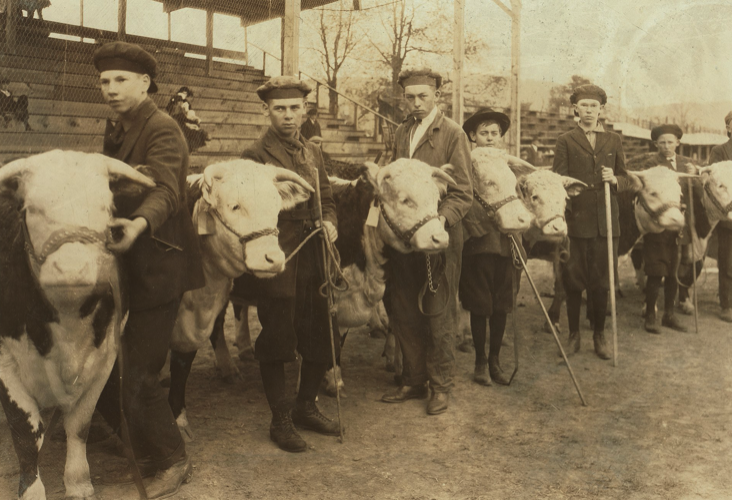Are you or your parents and grandparents one of the many Doddridge County youths who were fortunate enough to become a member of the Doddridge County 4-H Club in the last 100+ years? If so, did you know that this great organization is part of a nationwide educational program offered to our nation’s youths for over 100 years. It was first established by the U.S. Federal Cooperative Extension Service in conjunction with state and local partners in 1902. The many programs are made possible by the U.S. Dept. of Agriculture, county governments and state land-grant universities. Federal, state, and local extension staff as well as the many volunteer leaders are responsible for creating and conducting their programs.
As the National 4-H History Preservation Program writes on their website, “4-H didn’t really start in one time or place. It began around the start of the 20th century in the work of several people in different parts of the United States who were concerned about young people.
During the late 1800’s, researchers at public universities saw that adults in the farming communities did not readily accept the new agricultural discoveries being developed on university campuses – practices like using hybrid seed corn, milk sanitation and better home canning procedures. However, the researchers found that young people were open to new thinking and would “experiment” with new ideas and share their experiences and successes with their parents. In this way, rural youth programs became an innovative way to introduce new agriculture technology to their communities.
The seed of the 4-H idea of practical and “hands-on” learning came from the desire to make public school education more connected to country life. Early programs tied both public and private resources together for the purpose of helping rural youth.
A. B. Graham started one such youth program in Clark County, Ohio in January 1902; and O. J. Kern started a similar club one month later, in February 1902, in Winnebago County, Illinois. Many of these early clubs – which were project oriented – were called “Tomato Clubs” or “Corn Clubs” or “Pig Clubs” and “Canning Clubs”.
Jessie Field Shambaugh developed the clover pin with an H on each leaf in 1910, and by 1912 the groups were beginning to be called 4-H Clubs.
When Congress passed the Smith-Lever Act in 1914 and created the Cooperative Extension System at USDA, it included work of various boys’ and girls’ clubs involved with agriculture, home economics and related subjects, which effectively nationalized the 4-H organization.
Nearing its 50th anniversary, 4-H began to undergo several changes. In 1948, a group of American young people went to Europe, and a group of Europeans came to the United States on the first International Farm Youth Exchange. Since then, thousands of young people have participated in 4-H out-of-state trips and international exchanges. 4-H began to extend into urban areas in the 1950’s across the entire country, however 4-H programming had been going on in some cities as early as 1906 or 1908.
Later, the basic 4-H focus became the personal growth of the member. Life skills development was built into 4-H projects, activities, and events to help youth become contributing, productive, self-directed members of society. The organization changed in the 1960’s, combining 4-H groups divided by gender or race into a single integrated program.
Today, 4-H has an expansive reach, serving youth in rural, urban, and suburban communities in every state across the nation. Youth currently in 4-H are tackling the nation’s top issues, from global food security, climate change and sustainable energy to childhood obesity and food safety. 4-H out-of-school programming, in-school enrichment programs, clubs and camps also offer a wide variety of science, engineering, technology and applied math educational opportunities – from agricultural and animal sciences to rocketry, robotics, environmental protection and computer science – to improve the nation’s ability to compete in key scientific fields and take on the leading challenges of the 21st century.”
Its name (4-H), is in reference to the four “Hs” that are included in the original motto “Head, Heart, Hands, and Health” written by Otis E Hall of Kansas in 1918 and officially adopted in 1927. The pledge states, “I pledge my head to clearer thinking, my heart to greater loyalty, my hands to larger service, and my health to better living, for my club, my community, my country, and my world.” The words “and in my world” were added in 1973.
The motto evolved into the pledge so familiar to many of our nation’s youths today, “To make the best better.” While its slogan is “Learn by doing”. Membership nationwide totals 6.5 million and is now in over 50 countries. It might surprise you to know that as of 2016, there were nearly 6 million active youths in their membership.
Jennifer Sirangelo joined the National 4-H Council in 2006 and continues to lead the organization. Before working for 4-H, she served as regional vice president for Boys & Girls Clubs of America in New York. She also held leadership roles at the Boys & Girls Clubs of Greater Kansas City, the National Kidney Foundation, William Jewell College in Liberty, Mo.
To learn more about the history of the American idea which became the 4-H to know and respect today, I suggest a wonderful read by Thomas and Marilyn Wessel called ‘4-H: An American Idea 1900-1980’. It can be found at:
Next week, I shall cover the history of West Virginia’s own 4-H organizations and especially the community 4-H organizations throughout Doddridge County. So, check us out for The History of 4-H – WV and Doddridge County next week.
God Bless and Stay Well
Patricia Richards Harris
Doddridge County Historical Society

